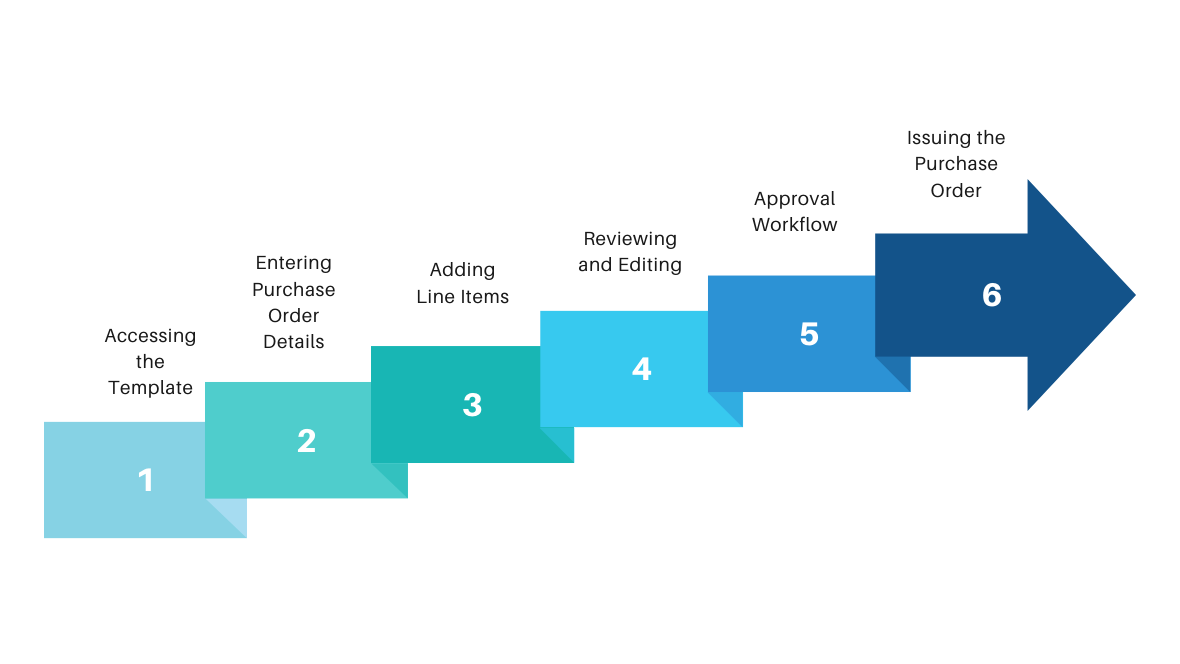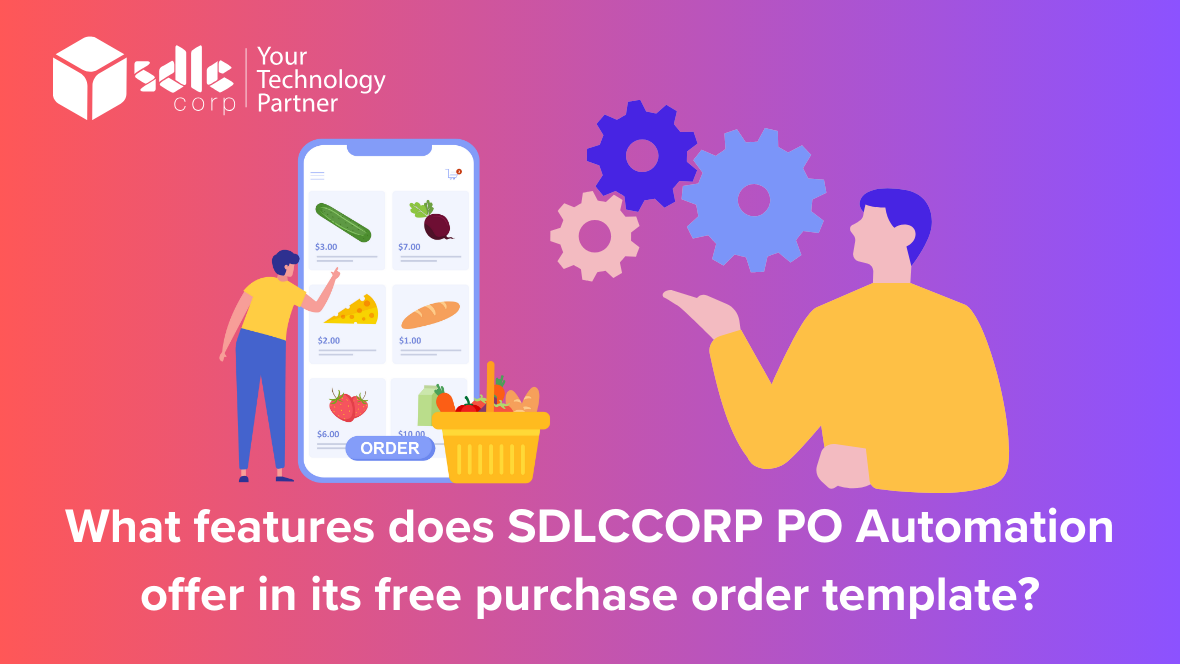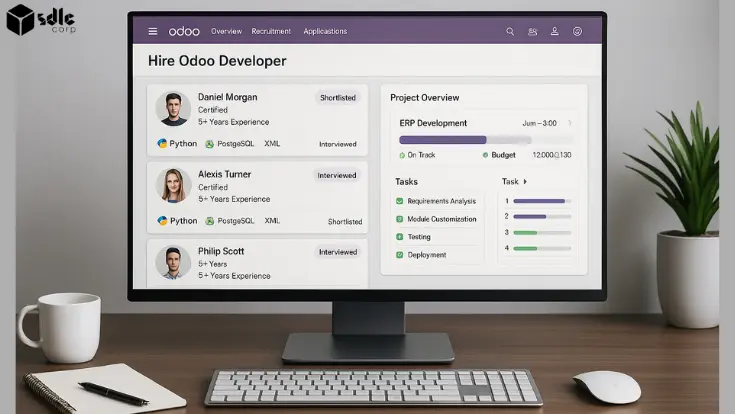What Features Does SDLCCORP Po Automation Offer in Its Free Purchase Order Template?
The SDLCCORP PO Automation’s free purchase order template boasts a comprehensive array of features designed to streamline procurement processes and enhance efficiency. Users can leverage customizable fields to tailor the template to their specific needs, ensuring seamless integration with existing workflows. With automated numbering functionality, the template eliminates manual input errors and maintains consistency across purchase orders. Vendor tracking capabilities allow businesses to maintain a centralized database of suppliers, facilitating better communication and negotiation.
Moreover, the template’s item categorization feature enables users to organize products or services systematically, simplifying inventory management and expenditure tracking. Built-in approval processes automate the authorization of purchase orders, reducing delays and ensuring compliance with internal policies. Real-time collaboration features enable team members to collaborate on purchase orders simultaneously, fostering greater transparency and accountability.
In the context of financial analysis and decision-making, integrating the keyword “return on equity ratio” into purchase order management can yield significant benefits. By tracking the financial performance of investments relative to equity, businesses can assess their profitability and efficiency in generating returns for shareholders. Integrating this metric into the purchase order process enables businesses to make more informed procurement decisions, aligning purchases with strategic goals and optimizing the allocation of resources.
How Its Work?
SDLCCORP PO Automation offers a comprehensive set of features in its free purchase order template, which streamlines the procurement process and enhances efficiency for businesses of all sizes. Here’s a detailed description of some key features:
1. Customizable Templates: The purchase order template is highly customizable, allowing users to tailor it to their specific business needs. This customization capability ensures that the purchase order aligns with the company’s branding and reflects its unique requirements.
2. User-Friendly Interface: The template features a user-friendly interface that makes it easy for users to navigate and input relevant information. Intuitive design elements ensure that even users with minimal technical expertise can effectively utilize the template.
3. Automated Calculations: SDLCCORP PO Automation incorporates automated calculations, reducing the risk of manual errors and ensuring accuracy in the procurement process. This feature automatically calculates totals, taxes, and other financial aspects, streamlining the purchasing workflow. By seamlessly integrating these calculations into purchase orders, businesses can expedite the process while maintaining precision, thereby enhancing overall operational efficiency.
4. Supplier Management: The template allows users to manage supplier information efficiently. Users can input supplier details, such as contact information and preferred payment terms, directly into the purchase order template, simplifying the procurement process and enhancing communication with suppliers.
5. Inventory Tracking: SDLCCORP PO Automation includes inventory tracking functionality within its purchase order template. Users can monitor inventory levels in real-time and adjust purchase orders accordingly to maintain optimal stock levels and prevent stockouts.
6. Approval Workflow: The template facilitates an approval workflow, enabling users to route purchase orders for approval before finalization. This feature enhances control over purchasing activities and ensures compliance with internal procurement policies.
7. Integration with Accounts Payable: One of the standout features of SDLCCORP PO Automation is its seamless integration with accounts payable systems. By incorporating the “accounts payable” keyword, we emphasize that the purchase order template streamlines the process of tracking and managing payments to suppliers. Integration with accounts payable systems enables automatic synchronization of purchase order data with the accounts payable ledger, facilitating efficient payment processing and reducing the risk of discrepancies.
8. Reporting and Analytics: The template provides reporting and analytics capabilities, allowing users to generate insights into purchasing trends, supplier performance, and expenditure patterns. These insights empower businesses to make informed decisions and optimize their procurement strategies for cost savings and efficiency gains.
Overall, SDLCCORP PO Automation’s free purchase order template offers a comprehensive suite of features designed to simplify the procurement process, improve accuracy, and enhance visibility into purchasing activities. Its integration with accounts payable systems further enhances efficiency by streamlining payment processing and ensuring seamless financial management.
Explore Free Purchase Orders: Unlock SDLC CORP's Features Now!

How to Use This Purchase Order Template?

Certainly! Here are six detailed steps on how to effectively use the purchase order template provided by SDLCCORP PO Automation:
1. Accessing the Template: Begin by accessing the purchase order template provided by SDLCCORP PO Automation. You can typically find this template on the SDLCCORP website or through the platform where you’ve downloaded the automation tool. Once downloaded, open the template in your preferred spreadsheet software, such as Microsoft Excel or Google Sheets. Ensure seamless accessibility and security by utilizing secure methods such as ACH transfer for transactions involving sensitive financial information.
2. Entering Purchase Order Details: Start by entering the relevant details for the purchase order. This includes information such as the purchase order number, date, and vendor/supplier details. Be sure to accurately input the required information to avoid any discrepancies or delays in the procurement process. Also, ensure to include the “purchase orders” keyword in your input data, so the system can categorize and process it correctly.
3. Adding Line Items: Next, add line items to the purchase order for each product or service you wish to procure. Include details such as the item description, quantity, unit price, and total price for each line item. This ensures clarity and accuracy in the order, helping both you and the supplier understand the scope of the purchase.
4. Reviewing and Editing: Take a moment to review the purchase order for accuracy and completeness. Double-check all entered information, including quantities, prices, and vendor details, to ensure they align with your procurement requirements. If necessary, make any edits or revisions to the purchase order before finalizing it.
5. Approval Workflow (if applicable): If your organization requires purchase orders to be approved before issuance, initiate the approval workflow as per your company’s procedures. Route the purchase order to the appropriate stakeholders for review and approval. Utilize the template’s built-in features for tracking approval status and ensuring timely sign-offs.
6. Issuing the Purchase Order: Once the purchase order is finalized and approved, it’s time to issue it to the vendor/supplier. You can do this by sending the purchase order via email or through your organization’s procurement system. Make sure to notify the supplier of the purchase order number and any other relevant details to facilitate smooth order processing and fulfilment.
By following these steps, you can effectively utilize the purchase order template provided by SDLCCORP PO Automation to streamline your procurement process and ensure accuracy in purchasing activities. Incorporating the “purchase orders” keyword in your data input helps categorize and process the information correctly within the template, optimizing its functionality for efficient purchase order management.
Dive into Purchase Orders: Discover SDLCCORP's Free Template Today!

What Are the Components of a Purchase Order?
Certainly! A purchase order typically consists of several key components that provide essential information for both the buyer and the seller. Here are six detailed descriptions of these components:
1. Header Information: At the top of a purchase order, you’ll find header information that identifies the document and its purpose. This section typically includes details such as the purchase order number, the date the order was issued, and the contact information for both the buyer and the seller. Clear header information helps in easy identification and tracking of the purchase order within the procurement process.
2. Supplier Details: The purchase order includes comprehensive information about the supplier or vendor from whom the goods or services are being purchased. This information typically includes the supplier’s name, address, contact information, and any relevant account numbers or identifiers. Clear and accurate supplier details ensure that the correct party receives the purchase order and facilitate effective communication throughout the transaction process.
3. Item Description and Specifications: One of the most crucial components of a purchase order is the detailed description of the items being ordered. This section includes information such as the quantity of each item, its description or part number, unit price, and any applicable specifications or requirements. Clear and specific item descriptions help to ensure that the buyer receives the correct products and reduce the risk of misunderstandings or disputes with the supplier.
4. Terms and Conditions: Purchase orders typically include terms and conditions that outline the rights, responsibilities, and obligations of both the buyer and the seller. These terms may cover aspects such as payment terms, delivery schedules, warranties, and dispute resolution procedures. Including clear and concise terms and conditions helps to mitigate potential conflicts and ensures that both parties are aware of their respective obligations.
5. Shipping and Delivery Information: The purchase order specifies shipping and delivery details to ensure that the ordered items reach the buyer’s designated location promptly. This section typically includes information such as the shipping method, delivery address, requested delivery date, and any special instructions or requirements for packaging and handling. Accurate shipping and delivery information helps to minimize delays and ensure smooth logistics operations.
6. Total Cost and Payment Information: Finally, the purchase order includes a summary of the total cost of the order and provides payment information for the buyer. This section outlines the subtotal, any applicable taxes or fees, and the total amount due. Additionally, it may specify the accepted payment methods, billing address, and any other relevant financial details. Clear and transparent payment information facilitates efficient payment processing and helps to avoid misunderstandings or delays in settling invoices.
By including these essential components, a purchase order serves as a formal document that facilitates clear communication, establishes mutual expectations, and ensures smooth transactions between buyers and sellers.
What Are the Steps Involved in the Purchase Order Process?

Certainly! Here are six detailed descriptions of the steps involved in the Purchase Order Process:
1. Purchase Requisition: The process typically begins with a purchase requisition initiated by a department or individual within the organization. This requisition outlines the need for specific goods or services and provides details such as quantity, specifications, and delivery requirements. The requisition is then reviewed and approved by authorized personnel, ensuring alignment with budgetary constraints and organizational policies.
2. Vendor Selection and Negotiation: Once the purchase requisition is approved, the next step involves selecting an appropriate vendor to fulfil the order. This may entail conducting market research, soliciting bids or proposals from multiple suppliers, and evaluating factors such as pricing, quality, reliability, and lead times. Negotiations with selected vendors may occur to finalize terms and conditions, including pricing, payment terms, and delivery schedules, to ensure a mutually beneficial agreement.
3. Purchase Order Creation: After vendor selection and negotiation, a purchase order (PO) is created based on the approved purchase requisition. The PO is a legally binding document that formalizes the agreement between the buyer and the supplier. It includes detailed information such as the item descriptions, quantities, prices, delivery dates, shipping terms, payment terms, and any other relevant terms and conditions. The PO is then reviewed and approved by authorized personnel within the organization before being sent to the supplier.
4. Order Fulfillment and Delivery: Upon receiving the PO, the supplier acknowledges the order and begins the process of fulfilling it. This typically involves picking, packing, and shipping the ordered items according to the specifications outlined in the PO. Throughout this process, the buyer may receive updates on the status of the order, including estimated delivery dates and any potential delays. Once the goods or services are ready for delivery, they are shipped to the buyer’s designated location.
5. Receipt and Inspection: Upon receiving the ordered items, the buyer conducts a thorough inspection to ensure they meet the specifications outlined in the PO and are free from defects or damage. This may involve checking quantities, quality, and conformity to agreed-upon standards. Any discrepancies or issues identified during the inspection are documented and communicated to the supplier for resolution. Once the items pass inspection, the buyer formally acknowledges receipt of the goods or services.
6. Invoice Processing and Payment: After the items are received and accepted, the supplier issues an invoice to the buyer for payment. The invoice typically includes details such as the PO number, itemized charges, quantities, prices, and payment terms. The buyer verifies the invoice against the corresponding PO and any related documentation, such as delivery receipts or inspection reports. Once verified, the invoice is approved for payment, and the accounts payable department initiates the payment process according to the agreed-upon terms, completing the Purchase Order Process.

What Advantages Does SDLCCORP PO Automation Provide, Including Its Provision of a Complimentary Purchase Order Template?
SDLCCORP PO Automation offers numerous advantages, including its provision of a complimentary purchase order template. Here are six detailed descriptions of these advantages, incorporating the accounts payable process flow:
1. Streamlined Procurement Process: SDLCCORP PO Automation simplifies the procurement process by providing a structured workflow for creating, approving, and managing purchase orders. The complimentary purchase order template serves as a foundation for this process, offering a standardized format that ensures consistency and clarity in communication with suppliers. Through seamless integration with accounts payable process flow, the system facilitates smooth transitions from purchase order generation to invoice processing and payment, reducing manual effort and minimizing errors.
2. Improved Accuracy and Compliance: By leveraging predefined fields and automated calculations within the purchase order template, SDLCCORP PO Automation enhances accuracy in procurement transactions. This accuracy extends to the accounts payable process flow, where validated purchase order data serves as the basis for invoice reconciliation and payment authorization. Additionally, the system enforces compliance with internal purchasing policies and regulatory requirements, reducing the risk of non-compliance penalties and financial discrepancies.
3. Enhanced Cost Control: With SDLCCORP PO Automation, businesses gain greater visibility into their purchasing activities, enabling them to monitor spending trends, identify cost-saving opportunities, and negotiate favourable terms with suppliers. The complimentary purchase order template facilitates budget tracking by capturing detailed information about ordered items, quantities, and prices. This information flows seamlessly into the accounts payable process flow, where it supports accurate budget forecasting, expense allocation, and variance analysis.
4. Efficient Supplier Management: SDLCCORP PO Automation streamlines supplier management by centralizing supplier information within the purchase order template. Users can easily access supplier contact details, contract terms, and performance metrics, facilitating informed decision-making and fostering stronger supplier relationships. Through integration with the accounts payable process flow, the system enables timely payments to suppliers, reducing the risk of late fees and supply chain disruptions.
5. Faster Approval Cycles: The purchase order template provided by SDLCCORP PO Automation expedites the approval process by automating routing and notification mechanisms. Users can define approval workflows based on predefined criteria, such as purchase amount thresholds or departmental responsibilities. As purchase orders progress through the approval chain, stakeholders receive real-time notifications and can provide timely feedback or authorization. This streamlined approval cycle accelerates procurement timelines and minimizes bottlenecks in the accounts payable process flow, ensuring prompt payment processing and supplier satisfaction.
6. Comprehensive Reporting and Analytics: SDLCCORP PO Automation offers robust reporting and analytics capabilities that empower businesses to gain actionable insights into their procurement and accounts payable performance. The purchase order template captures data on purchasing patterns, supplier performance metrics, and cost-saving initiatives, which can be analyzed to identify trends and opportunities for process optimization. By integrating accounts payable process flow data with procurement analytics, businesses can track key performance indicators (KPIs) such as invoice processing times, payment accuracy, and cash flow forecasting accuracy, enabling continuous improvement and strategic decision-making.
Conclusion
In conclusion, SDLCCORP PO Automation’s provision of a free purchase order template is a significant boon for businesses seeking to streamline their procurement processes. By integrating advanced features into their template, SDLCCORP empowers users to efficiently manage their purchasing activities while enhancing accuracy and compliance. Moreover, the inclusion of financial statement analysis capabilities underscores the platform’s commitment to providing holistic solutions for business optimization.
With SDLCCORP’s free purchase order template, businesses can effectively track their procurement activities, manage supplier relationships, and ensure adherence to internal policies and regulations. The template’s customizable nature enables organizations to tailor it to their specific needs, aligning with their branding and operational requirements.
Furthermore, the integration of financial statement analysis functionality adds another layer of value to SDLCCORP’s offering. By incorporating this keyword, we emphasize the platform’s ability to not only facilitate procurement but also provide insights into the financial health and performance of the organization. Through robust reporting and analytics features, users can leverage the purchase order data to conduct comprehensive financial statement analysis, identify trends, and make data-driven decisions.
Overall, SDLCCORP PO Automation’s free purchase order template, coupled with financial statement analysis capabilities, represents a comprehensive solution for businesses looking to optimize their procurement processes and gain deeper insights into their financial performance. By leveraging these tools, organizations can streamline operations, enhance efficiency, and drive strategic growth initiatives.
FAQs
1. Is the purchase order template customizable to fit our specific business needs?
Yes. Our purchase order template is highly customizable, allowing you to tailor it to your unique requirements. You can easily add or remove fields, adjust formatting, and incorporate your company’s branding to ensure it aligns perfectly with your purchasing processes.
2. Does the template support automated calculations for totals, taxes, and discounts?
Yes, the purchase order template includes built-in functionality for automated calculations. This feature helps to minimize manual errors and ensures accuracy in your purchasing transactions. You can rely on the template to calculate totals, taxes, and any applicable discounts automatically, saving you time and effort.
3. Can multiple users collaborate on a single purchase order using this template?
Absolutely. Our purchase order template is designed to facilitate collaboration among multiple users. You can easily share the template with colleagues or stakeholders involved in the procurement process, allowing them to input their respective information and track the progress of purchase orders in real time.
4. Is there a built-in approval workflow to ensure compliance with our company's purchasing policies?
Yes, our purchase order template includes an approval workflow feature to help you enforce your company’s purchasing policies. You can set up predefined approval chains and route purchase orders to the appropriate stakeholders for review and approval before finalization. This ensures that all purchases adhere to your organization’s guidelines and compliance standards.
5. Does the template integrate seamlessly with our existing accounts payable system?
Absolutely. Integration with your accounts payable system is seamless with our purchase order template. Whether you’re using a standalone accounting software or a comprehensive enterprise resource planning (ERP) system, our template can be easily synchronized with your accounts payable ledger. This ensures consistency in financial data and streamlines the payment processing workflow, from purchase order creation to invoice settlement.
Contact Us
Let's Talk About Your Project
- Free Consultation
- 24/7 Experts Support
- On-Time Delivery
- sales@sdlccorp.com
- +1(510-630-6507)















